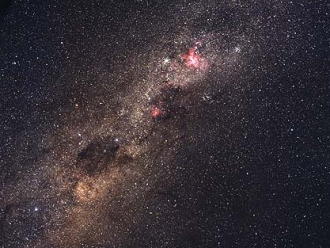
In Star Trek, a black cluster is phenomenon that is created when numerous protostars collapsed in close proximity to one another. The result of this collective collapse was an area of space that absorbs energy and dangerously affects spacecraft systems. In The Star Trek: The Next Generation episode "Hero Worship", contact was lost with the SS Vico, which was assigned to explore a black cluster, located in Sector 97. The USS Enterprise-D was sent to investigate and, upon its' arrival on the edge of this black cluster, found the destroyed hulk of the Vico, with only a young boy as the sole survivor. The Enterprise itself was almost destroyed while further investigating the Vico's disappearance.
In real astronomy, when proto-stars collapse, they get hotter and may be formed into true stars or brown dwarfs - not "black clusters". A proto-star is a star that has not yet initiated fusion. Stars begin their life as a cool cloud of gas. As the cloud begins to collapse under its own gravity, it releases its gravitational energy as radiation. As the proto-star continues to collapse, it gets hotter and hotter until it the collapse stops due to gas pressure. Their cores may now be hot enough to begin burning hydrogen. When a star "turns on" its hydrogen-burning phase, we say that it has reached the main sequence, and is a true star, not a protostar, brown dwarf, or planet.

The
Black Cluster depicted in 'Hero Worship'
While there are no 'black clusters' in astronomy, there are dark nebulae - a type of interstellar cloud that is so dense that it obscures the light from any background emission or reflection nebula (e.g., the Horsehead Nebula) or it blocks out background stars (e.g., the Coalsack Nebula). The extinction of the light is caused by interstellar dust grains located in the coldest, densest parts of larger molecular clouds. Clusters and large complexes of dark nebulae are associated with Giant Molecular Clouds. Isolated small dark nebulae are called Bok globules. The form of such dark clouds is very irregular: they have no clearly defined outer boundaries and sometimes take on convoluted serpentine shapes. The largest dark nebulae are visible to the naked eye, appearing as dark patches against the brighter background of the Milky Way.

